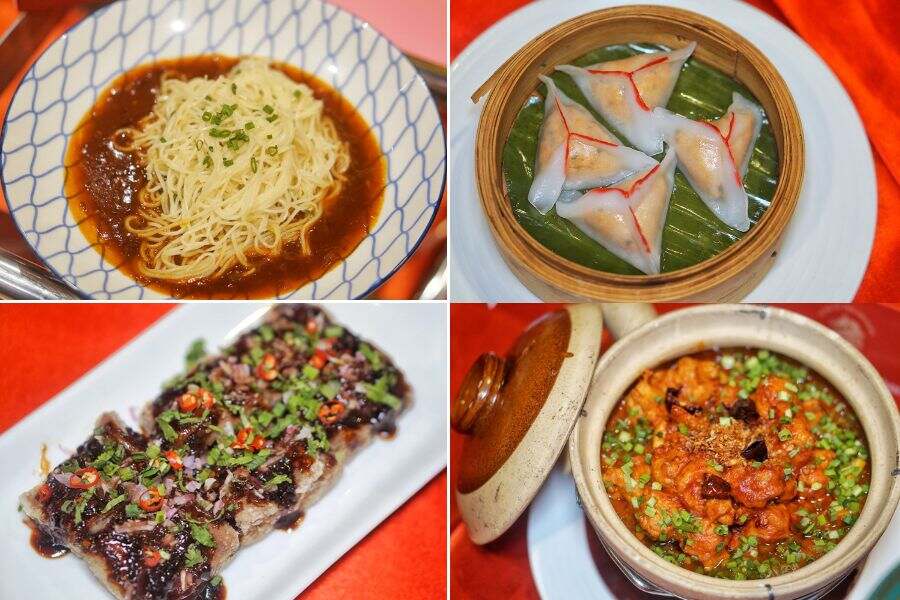The world faces an epicurean conundrum. Many cities have openly attacked diaspora culture and food as a threat encroaching local cuisine. As a foodie, I think any struggle for food dominance is unsavoury. Venice has banished kebabs. Goa, our own seaside state, has decreed Gobi Manchurian strictly off the menu. We have heard that one person’s wine is another’s poison, but to declare Gobi and its gravy as outlaws? No offence to Venice or Goa, but Kolkata cannot be the fence-sitter.
The drums of the dragon dance in Kolkata’s Chinatown are enough to drown the noisy debate. On February 10, the Chinatowns of Kolkata reverberated with drums and lit up with red lanterns. It is an unbroken legacy of 300 years, where Kolkata’s Chinese community celebrates the traditional lunar new year. The narrow alleys of Tirretti Bazar and Tangra turn into stomping grounds of Chinese mythical spirits. However, the sizzling chemistry of Chinese cuisine and Kolkata is no myth.

A dragon dance is performed as part of the Chinese Year of the Wood Dragon celebrations at Tangra’s Pei May School, in February Soumyajit Dey
For generations, we have celebrated Chinese and Bengali cuisines for their distinctive richness. If you mix the two, you get Gobi Manchurian, which is a mistake on many fronts. But if you banish one to protect the other, it is worse — you miss a cultural evolution. And of course, we would never have my favourite dishes from my earliest memories — Pan Fried Noodles and Lamb in Hoisin Sauce.
Every Kolkatan has a favourite Chinese restaurant, a tempting Chinese bite and a family tradition of gathering around a Chinese feast. Nan King, Peiping, Waldorf and other Chinese establishments not only gave us flavours to die for; they paved the way for a gourmet city that beats the best of the world in cuisine. It also led to new flavours that have flourished across the globe as Tangra Chinese or Kolkata Chinese.

Chinese establishments not only gave us flavours to die for; it also led to new flavours that have flourished across the globe as Tangra Chinese or Kolkata Chinese. Above, a selection of dishes from Mainland China’s menu Soumyajit Dey
In the 1800s, when the city was a gateway to the East, Tong Tai Chow was the first Chinese trader who came to Bengal and leased a land near Budge Budge for a sugar mill. He soon passed away, leaving a handful of Chinese workers in search of a livelihood. They reached Tiretti Bazar in Calcutta. Named after a Venetian Surveyor, Edward Tiretta, Tiretti was a cultural melting pot, home to Persians, Greeks, Armenians, Portuguese and Chinese. A Parsi Fire Temple, an Armenian church and a Chinese temple bear testimony to how the whole wide world once thrived in this little corner. The resourceful Chinese soon carved their own identity as carpenters, dentists, shoe makers and leather tanners. Families opened home kitchens serving glass noodles and broths, dim-sums and baos.

A Parsi Fire Temple, an Armenian church and a Chinese temple bear testimony to how the whole wide world once thrived in this little corner of Kolkata Rangan Datta
New ingredients like cumin, coriander, green chilli, ginger, wheat flour and spinach found a place next to Hakka staples like soy sauce, tofu, fermented black beans, mustard greens, pickled radish, salted duck eggs and cured pork belly. Together, they engendered the most fascinating Calcutta specialities like Hakka Noodles, Chilli Chicken and Szechuan Sauce. Factories sprouted around Tiretti, churning out noodles and sauces for a burgeoning food business.

For a few hours every week, Tiretti Bazar turns into the Silk Route of ancient times, which was dotted with tea houses, giving tired travellers hot tea and fresh food
Another speciality of Tiretti Bazar is the early morning breakfast market, bustling with dim dum vendors and customers even before sun-up. For a few hours every week, the lane turns into the Silk Route of ancient times, which was dotted with tea houses, giving tired travellers hot tea with fresh food. Vendors and makeshift stalls pop up all along the Tiretti lane, ladling out steaming delicacies like Toufa Kok or meatball soups, Sesame Ball, Bao Zi (meat-filled bao), Cha Siu Bao, Siu-Mai, that is buns filled with pork, and many other dumplings, broths and sweet rice or bean paste-filled cakes.

For a few hours every week, vendors and makeshift stalls pop up all along the Tiretti lane, serving up steaming delicacies iStock
Kolkata is a world city in the truest sense. Not because we never felt threatened by any food, Manchow or Manchester, beyond the odd irritable bowel syndrome. If this city has sent out the second largest cuisine for the rest of India and many parts of the world, it is with the message of global friendship. Economic development can be sustainable only with a vibrant, happy urban culture. Kolkata pulsates with food and friendship. Food is the peace pipe for all urban tribes. If the dragons are rocking in this city, global industries and techno giants cannot be far behind.

‘Economic development can be sustainable only with a vibrant, happy urban culture. Kolkata pulsates with food and friendship,’ says Anjan Chatterjee TT Archives
Anjan Chatterjee is the chief of Speciality Restaurants, which owns Mainland China, Asia Kitchen by Mainland China, Oh! Calcutta, Sigree Global Grill, Café Mezzuna, Hoppipola, Barissh and many more. And yes, he is a foodie! He is at acgenx@gmail.com


